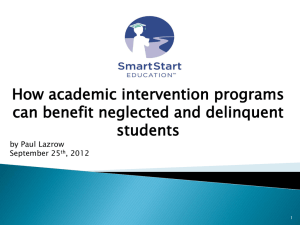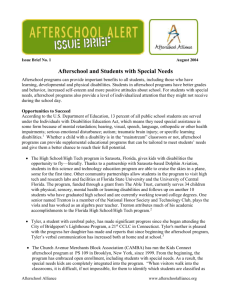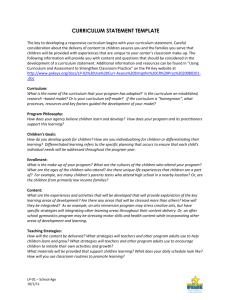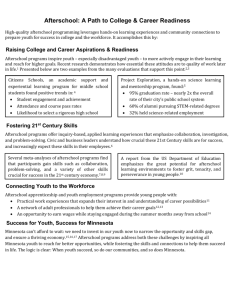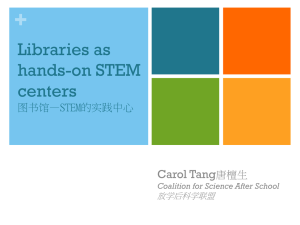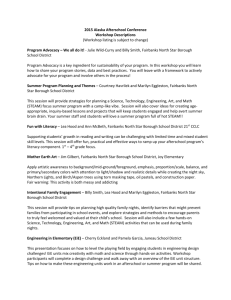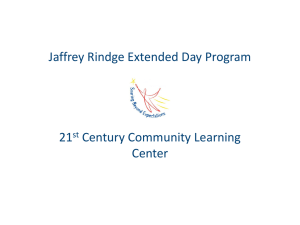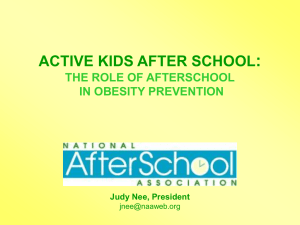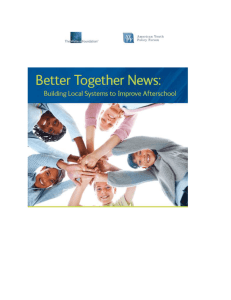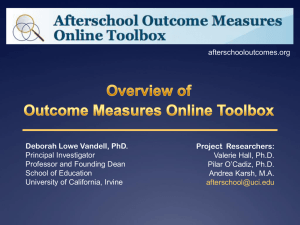Presenters - Jim Casey Youth Opportunities Initiative
advertisement
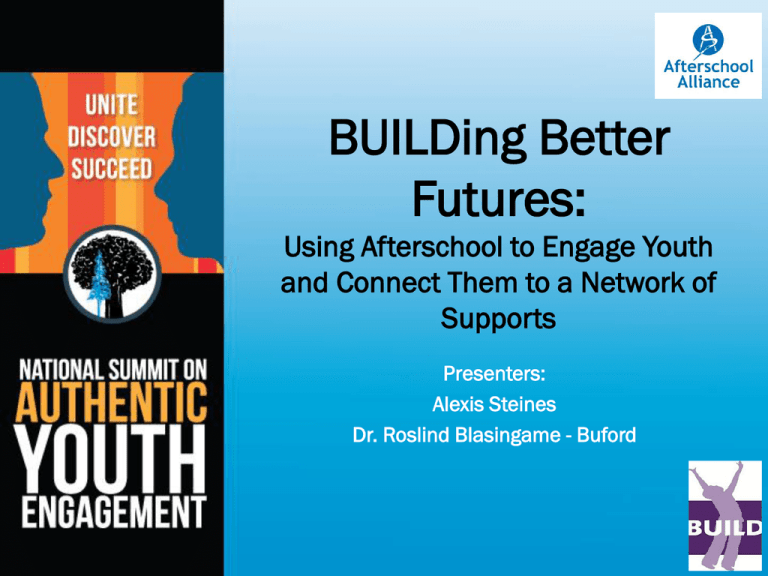
BUILDing Better Futures: Using Afterschool to Engage Youth and Connect Them to a Network of Supports Presenters: Alexis Steines Dr. Roslind Blasingame - Buford How are you engaging youth out of school / afterschool? About the Afterschool Alliance • National non-profit based in DC • Wide & deep reach at the grassroots & grasstops o Work with more than 25,000 program providers o 42 statewide afterschool networks o 100+ Afterschool Ambassadors at the city level o Bipartisan afterschool caucus in House & Senate • Systems-building approach: 1 Field-Building 2 3 Research Policy, Advocacy & Communications What is afterschool? • A program that a child attends regularly • Provides a supervised, enriching environment in the hours after the school day ends • Usually offered in a school or a recreation / community center • Different from individual activities, such as sports, special lessons or hobby clubs As defined in America After 3 PM: A Household Survey on Afterschool In America, 2009 America After 3PM America After 3PM 2009 Compared to 2004 National Percentages 2009 2004 Kids in Afterschool Programs 15% 11% Kids in Self Care 26% 25% Kids in Sibling Care 14% 11% 89% 91% 38% 30% Parents Satisfied with Afterschool Program Kids Who Would Participate if a Program were Available Kids in Summer Learning Programs 25% -- • 8.4 million kids participate in afterschool programs • 15.1 million kids on their own after school •New American After 3 data this fall! New Research on Afterschool Outcomes New research from Dr. Deborah Lowe Vandell, UC Irvine School of Education BUILD HISTORY • BUILD’s programs have served more than 90,000 youth throughout our 45 years of existence. • Landmarks of our growth include: – – – – – – – – – – – – – • 1969 – BUILD established 1973 – Prevention Program Launched 1982 – Community Development Program began 1993 – Project BUILD created 2000 – Initiated our Teen REACH After-School Program 2002 – Youth Council started 2003 – Launched BUILDing Futures 2006 – Formalized the BUILD Model 2007 – Talent Search began 2009 – Humboldt Park Cluster Pilot Launched 2012 – Launched Health & Wellness Program 2013 - Brand BUILD Arts Academy (B.B.A.A.) created 2014 – BUILDing Communities Together (BCT) formalized Today BUILD is in 11 communities, serving over 3,000 youth annually. BUILD Mission & Vision • MISSION: BUILD engages at-risk youth in the schools and on the streets so they can realize their educational and career potential and contribute to the stability, safety and well-being of our communities. • VISION: By 2020, BUILD will be recognized and sought out nationally as a premier provider of proven-effective Youth Development services targeted for at risk youth and communities. BUILD’s youth will serve as ambassadors, living examples of how the BUILD Model transforms youth from “at risk” to “at hope” and, ultimately, to respected, contributing members of society. Population Served • • Ages (6-27) Risk Factors include: – Behavior and academic problems in school – Negative use of out-ofschool time – Location of residence – Family issues – Youth not enrolled in school – Youth or Family members affiliated with gangs – Youth or Family members involved in juvenile or criminal justice system • Neighborhoods 1. Belmont Cragin 2. Hermosa 3. Logan Square 4. Austin 5. Humboldt Park 6. West Town 7. Near North Side/Cabrini Green 8. East Garfield Park 9. North Lawndale 10. Brighton Park 11. Englewood “At-Hope” Youth At BUILD, We focus on the tremendous potential and deliver the message that we believe our youth will accomplish great things. BUILD’s Programs • Prevention • – In-School Activities – After- and Out-of-School Activities – Community Outreach • Intervention – Gang/Violence Remediation – Project BUILD – BUILD Peace Leagues • BUILDing Futures • – College Access – Career Readiness – BUILDing Bridges to Manhood – Becoming Women – Brand BUILD Youth Leadership Development (Under BUILDing Futures) – Youth Council: “INDAGLO” (The Light Within the Darkness) – Y-MAD (Youth Making A Difference) – HEY-U (Highly Empowered Youth United) Special Projects – Humboldt Park Cluster Model – East Garfield Cluster Model – Culture of Calm Initiative – YESS Program BUILD’s Programs (cont’d) • Health & Wellness – Affordable Care Act (ACA) – Mind, Exercise, Nutrition, Do It! (MEND) • BUILDing Communities Together (BCT) – Data Collection – Program Evaluation – Capacity BUILDing – Leadership Development BUILD Model Why we’re successful: M&M’s Meet YOUTH Where They are … Make a Genuine Connection… Master Their Needs & Interests… Maintain Positive Relationships…. Move Them from Margins to Mainstream Motivate them to Become Program Ambassadors… BUILD Methodologies Positive Youth Development (PYD) builds on the assets of youth rather than the deficits. Positive Youth Development Asset-Based Community Development (ABCD): Working in partnership with others to provide youth with all the resources needed. StrengthBased Change Model Asset Based Community Development Appreciative Inquiry Appreciative Inquiry (AI): A way of bringing about change that shares leadership and learning The 4 stages of AI are: Discovery, Dream, Design and Destiny. Performance Management • • • BUILD’s Commitment to Data – Center for Latino Research at DePaul University (mid-1990’s) – Loyola University (1999) – Illinois Center for Violence Prevention (2006) – University of IL at Chicago, Masters of Youth Development Program (2012) – Evaluation for Change (2013) Systems & Tools – Group Activity Reports – Youth Profile – Youth Life Plan Self-Assessment & Reflection – Health Assessment – Mutual Accountability Plan (MAP) – Efforts to Outcomes (ETO) Accomplishments & Highlights – Chicago ETO User Group – Perform Well webinar (Performance Management to Becoming Evidence-Based) – After the Leap Showcase in Washington, D.C. – MetLife Award BUILD Designations & Replication Designations: • • • • • “Promising Practice” (Office of Juvenile Justice & Delinquency Prevention) “Exemplary Practice” (Chicago Community Trust) “Innovative Practice” (Department of Education Trio Programs) “Effective Programs” (Office of Justice Programs) “Four-Star Charity” (Charity Navigator) Model Replication: Department of Public Health (Minneapolis, MN) Luz Social Services (Tucson, AZ) The Prevention & Addictions (Corpus Christi, TX) International Center for Conflict Engagement (Houston, TX) Advocating for Afterschool Things to think about: What are your immediate goals? Long-term, short-term, immediate? Who are your allies? Who supports summer learning or afterschool in your community? Who are you targeting? How do you plan to get the attention of each target? Key Messages • Afterschool programs: • Keep kids safe • Engage kids in learning • Help working families At their best when they complement but don’t replicate the school day • Afterschool programs are also community-school partnerships • Questions? Dr. Roz Blasingame-Buford Executive Director BUILD 773-227-2880 contactus@buildchicago.org rblasingame@buildchicago.org FACEBOOK: BuildChicago Twitter: @BUILD_ Chicago Alexis Steines Field Outreach Manager Afterschool Alliance 202-347-2030 asteines@afterschoolalliance.org Facebook: afterschoolalliancedc Twitter: @afterschool4all

